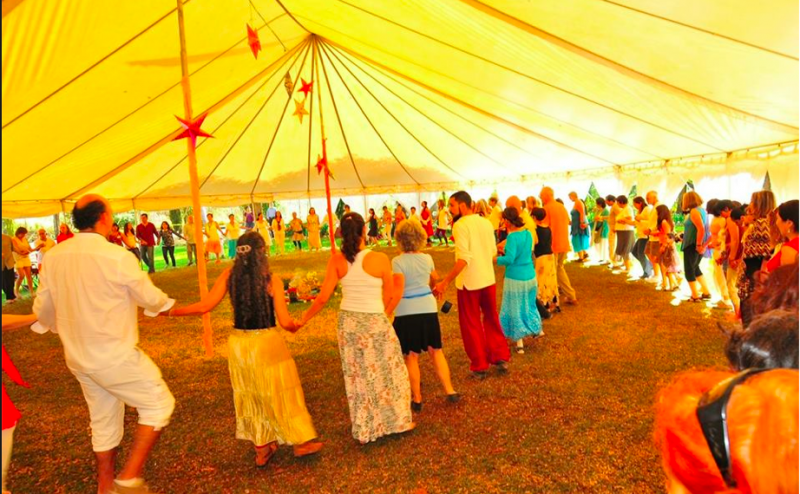What is Circle Dance?
Before humans even used words to communicate, it is likely that we were dancing together. The circle is the most common way for people to gather throughout time, and all ancient cultures have dances that are done in a circle.
The movement of Circle Dance draws on the rich and diverse traditional dances of many countries, as well as modern music with adaptations of traditional steps or new
choreographies.
Our intention is to focus on the internal experience, the group consciousness, be open to transformation, experience joy, awareness, unity, and gratitude, and share these with our communities.
Who can dance?

Anyone of any age or ability can Circle Dance. Each dance is taught, the emphasis is on the inner experience (not a performance) and everyone is welcome.
So come on your own or with a friend (you do not need a partner) and join in. Circle Dance groups meet regularly all over the world, and hold special events, dance days, weekends, festivals, and Circle Dance holidays.

Mission
Our vision is that everyone knows what Circle Dance is and it is available to everyone.
A brief history...
The movement of Circle Dance was born in the 70’s in the Findhorn Foundation, a spiritual and ecological community in northern Scotland. In 1976, there was a conference on “European Spiritual Renewal” and German dance professor Bernhard Wosien was invited.
He had the intention of working with the sacred and ritual aspects of the old dances,and called it “Helige Tanze”. Bernhard continued to work with a group of dancers at Findhorn and the name was translated variously as Sacred Dance, Sacred Circle Dance,and Circle Dance.
As well as being an important focus for specific work with Bernhard Wosien, Circle Dance was used as a way of integrating and centering the participants of the workshops at Findhorn. Many people enjoyed it so much that they wanted to continue once they returned home, and Circle Dance began to spread throughout the UK and then into the rest of the world in the mid 1980’s, due to the influence of numerous people including David Roberts, Janet Rowan Scott, Colin Harrison, Errol Masters and Rosie James.

Is Circle Dance the same thing as Dances of Universal Peace?
No, although the two are like cousins. They are both done in circles and have similar intentions, though with very different dynamics, music, and patterns.

Why haven't i heard of it before?
Even yoga was relatively unknown outside of India before the 1950’s. Now is a good moment to make Circle Dance available to everyone.

Benefits of Circle Dance
The benefits of Circle Dance include increased balance, coordination, flexibility, sense of rhythm, and self acceptance. If you have ever said “I am not a dancer” or “I have 2 left feet” then you will be amazed by the fact that after some practice your whole belief system about yourself can change. You can increase your sense of what is possible. Holding hands and dancing in a circle brings an experience of connection with other people. Group awareness and cooperation is enhanced, and this facilitates any kind of gathering, activity, project or communication. You may easily have a transpersonal experience which increases health on many levels.
Many of the dances are very old and we learn something non-verbally through the messages encoded in these ancient patterns. With Circle Dance many aspects of our self are integrated: body, mind, spirit, and heart. It is grounding and increases our awareness of our body and emotions. As we dance the movement becomes a meditation: as soon as our minds stray we may lose the step…yet try too hard and we may also lose it. The freedom and bliss that come in moments of this balanced awareness are very rich. This in itself is healing. Parts of the brain that may be dormant come alive, and increased intelligence can then be developed.
Many modern day entertainments are very passive. When we jump in to Circle Dance we are actively engaging ourselves. Our ability to respond and participate has many implications in the transition into a more aware society. Even though we may not know very much about another culture, dancing their dances connects us, and we can learn real respect for diversity. Moving physically helps move stuck mental patterns and physical patterns. Learning new patterns of movement increases the neuroplasticity of our brains. Having fun reduces stress, which is essential for good health.
Circle Dance magnifies the amplitude and amplifies the magnitude of our natural power, which when focused with love and good intentions can achieve amazing results. It brings people together, and even people who are incompatible at first become more loving and accepting of each other over time. Circle Dance helps us see that we have a lot in common and is a very effective tool in building real peace.
Universities
Team Building
Drug and Alcohol Rehabilitation Centers
are some the first venues where we will introduce Circle Dance as a tool for social health and wellbeing
As part of our mission we are training new teachers every year and opening up avenues of scientific research


